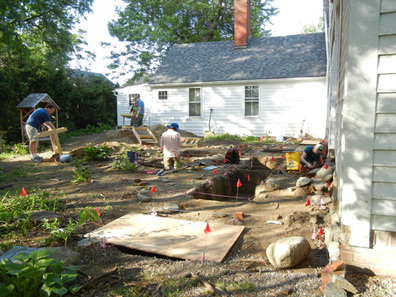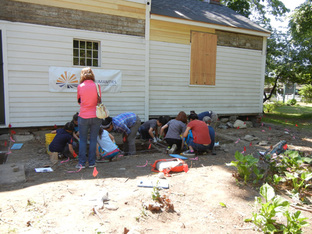Digging Northampton's History:
Parsons House Community Archaeology Dig

From May 19–June 6 2015, archaeologist Linda Ziegenbein oversaw a public archaeological excavation at the 1719 Parsons House at Historic Northampton. Students from Leeds Elementary School, Ryan Road Elementary School, the Pioneer Valley Chinese Immersion Charter School and North Star Self-Directed Learning for Teens visited the dig site to learn archaeology first-hand. Dig open hours and three Saturday "Public Days" held May 23, May 30 and June 6 drew over 200 visitors and volunteers.
The excavation, Digging Northampton's History, was made possible by a project grant from Mass Humanities. The grant was matched with $3,500 in donations contributed by Historic Northampton donors on Valley Gives Day 2014 and through in-kind project donations.
The excavation, Digging Northampton's History, was made possible by a project grant from Mass Humanities. The grant was matched with $3,500 in donations contributed by Historic Northampton donors on Valley Gives Day 2014 and through in-kind project donations.

The excavation focused on two areas: 1. inside the house beneath the floor of an 18th century addition and 2. outside the house in the rear yard (shown above). These are two places were Parsons House residents would have discarded trash outside their backdoor in an area known as a midden. Parsons House was built in 1719 by Nathaniel Parsons, a grandson of Cornet Joseph Parsons and Mary Bliss Parsons. The original house consisted of four rooms and a central chimney. In the mid-to-late 18th century, a kitchen lean-to was added to the rear of the house. The floorboards of the lean-to addition were temporarily removed to unearth the objects below.
A variety of objects discarded by various residents of the house were uncovered over the three-week long dig. Digging 10 centimeters at a time, archaeology staff, visiting students and volunteers sifted through dirt to uncover artifacts. The recovered items were washed and brushed and organized for the artifact cataloging process. Archaeology staff blogged daily, describing the day-to-day activities and findings in a project diary on the Digging Northampton's History website. "We ended up finding a lot of cow, sheep and pig bone," Ziegenbein said. "These things allow us to understand what they were eating, the diet and their food preferences." Other findings included everyday household items such as sewing pins and fragments from bottles, plates and bowls as well as a lice comb and a bone-handled toothbrush, broken at the neck.
A variety of objects discarded by various residents of the house were uncovered over the three-week long dig. Digging 10 centimeters at a time, archaeology staff, visiting students and volunteers sifted through dirt to uncover artifacts. The recovered items were washed and brushed and organized for the artifact cataloging process. Archaeology staff blogged daily, describing the day-to-day activities and findings in a project diary on the Digging Northampton's History website. "We ended up finding a lot of cow, sheep and pig bone," Ziegenbein said. "These things allow us to understand what they were eating, the diet and their food preferences." Other findings included everyday household items such as sewing pins and fragments from bottles, plates and bowls as well as a lice comb and a bone-handled toothbrush, broken at the neck.
 This program is funded in part by Mass Humanities, which receives support from the Massachusetts Cultural Council and is an affiliate of the National Endowment for the Humanities.
This program is funded in part by Mass Humanities, which receives support from the Massachusetts Cultural Council and is an affiliate of the National Endowment for the Humanities.
Linda Ziegenbein was engaged to plan and implement the excavation in fall 2014. At that time, it was determined that Historic Northampton needed to build a foundation under this section of the house to solve serious structural problems. After receiving a $176,465 grant from the Northampton Community Preservation Fund to fund the restoration work, Historic Northampton made the dig the focus of its December 2014 Valley Gives Day fundraising campaign. Valley Gives Day donors contributed $3,500 towards the dig to match a project grant from Mass Humanities, awarded in spring 2015.
Dr. Ziegenbein received a doctorate in anthropology from the University of Massachusetts at Amherst in 2013. She was a founding member of the David Ruggles Center in Florence, writing her dissertation on David Ruggles' life in Florence. Other team members included Jill Zuckerman of UMass Archaeological Services; Elena Sesma, who is working on her doctorate with a focus on historical archaeology and critical heritage studies and Mary Larkum, a doctoral candidate at the University of Massachusetts who specializes in bioarchaeology which includes the study of animal bones.
The findings of the excavation will add to the body of research relating to the Parsons House. In the early 1990s, a building archaeology was conducted by the Society for the Preservation of New England Antiquities (now Historic New England) resulting in a 147-page architectural examination documenting the original house and subsequent additions as the house was remodeled by succeeding generations of owners.
News Coverage of the Archaeological Dig:
Dr. Ziegenbein received a doctorate in anthropology from the University of Massachusetts at Amherst in 2013. She was a founding member of the David Ruggles Center in Florence, writing her dissertation on David Ruggles' life in Florence. Other team members included Jill Zuckerman of UMass Archaeological Services; Elena Sesma, who is working on her doctorate with a focus on historical archaeology and critical heritage studies and Mary Larkum, a doctoral candidate at the University of Massachusetts who specializes in bioarchaeology which includes the study of animal bones.
The findings of the excavation will add to the body of research relating to the Parsons House. In the early 1990s, a building archaeology was conducted by the Society for the Preservation of New England Antiquities (now Historic New England) resulting in a 147-page architectural examination documenting the original house and subsequent additions as the house was remodeled by succeeding generations of owners.
News Coverage of the Archaeological Dig: